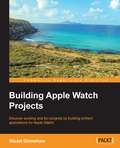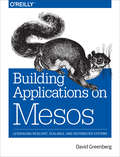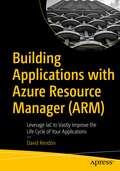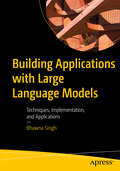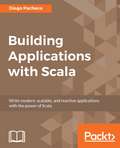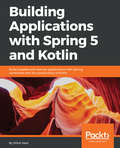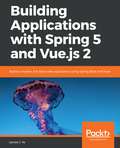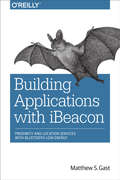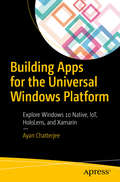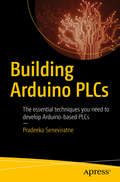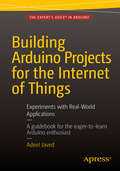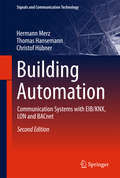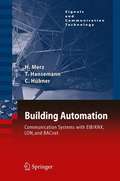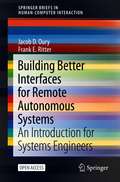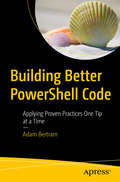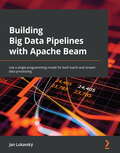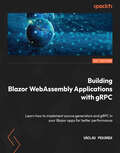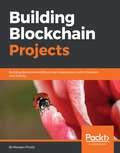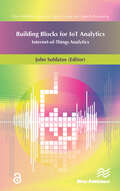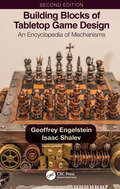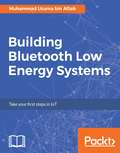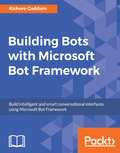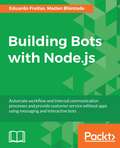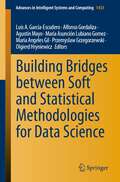- Table View
- List View
Building Apple Watch Projects
by Stuart GrimshawDiscover exciting and fun projects by building brilliant applications for the Apple Watch About This Book * Explore the opportunities opened up to developers by Apple's latest device: the Apple Watch * Be a crackerjack at developing software across a broad range of watch app categories * From an eminent author, master all stages of development, from the first stage through to a completed project Who This Book Is For If you have some basic knowledge of programming in Swift and are looking for the best way to get started with Apple Watch development, this book is just the right one for you! What You Will Learn * Understand the concept of the Apple Watch as an autonomous device as well as it being paired with the iPhone * Get your app up and running * Design exciting, inspiring, and attractive layouts for your apps * Make your user interface more engaging using images and animation * Enable your Watch and iPhone apps to transport and share data * Leverage the feature-rich set of WatchKit technologies provided by Apple * Connect your apps to the Internet * Submit your app to the App Store In Detail With Apple's eagerly anticipated entry into the wearable arena, the field is wide open for a new era of app development. The Apple Watch is one of the most important technologies of our time. This easy-to-understand book takes beginners on a delightful journey of discovering the features available to the developer, right up to the completion of medium-level projects ready for App Store submission. It provides the fastest way to develop real-world apps for the Apple Watch by teaching you the concepts of Watch UI, visual haptic and audio, message and data exchange between watch and phone, Web communication, and finally Visual, haptic as well as audio feedback for users. By the end of this book, you will have developed at least four fully functioning apps for deployment on watchOS 2. Style and approach This is a step-by-step guide to developing apps for the Apple Watch with the help of screenshots and fully coded working examples.
Building Applications on Mesos: Leveraging Resilient, Scalable, and Distributed Systems
by David GreenbergHow can Apache Mesos make a difference in your organization? With this practical guide, you’ll learn how this cluster manager directs your datacenter’s resources, and provides real time APIs for interacting with (and developing for) the entire cluster. You’ll learn how to use Mesos as a deployment system, like Ansible or Chef, and as an execution platform for building and hosting higher-level applications, like Hadoop.Author David Greenberg shows you how Mesos manages your entire datacenter as a single logical entity, eliminating the need to assign fixed sets of machines to applications. You’ll quickly discover why Mesos is the ultimate DevOps tool.Understand Mesos architecture, and learn how it manages CPU, memory, and other resources across a clusterBuild an application on top of Mesos with Marathon, a platform for hosting services on MesosCreate new, production-ready frameworks for MesosWrite a custom executor to provide richer interaction between the Mesos scheduler and workersDive into advanced topics, including the reconciliation process, Docker integration, dynamic reservations, and persistent volumesLearn about today’s Mesos initiatives that will likely become tomorrow’s features
Building Applications with Azure Resource Manager (ARM): Leverage IaC to Vastly Improve the Life Cycle of Your Applications
by David RendónLearn how to leverage infrastructure as code with Azure Resource Manager (ARM) and the best practices to build, test, debug, and deploy your applications in Microsoft Azure using ARM templates and the new domain-specific language Bicep.As organizations consider moving partially or fully to the cloud, infrastructure as code (IaC) has become a key component to improving time to market for their applications. However, it is critical that enterprise infrastructure professionals use the right resources and strategies to build the infrastructure required to run applications in the cloud. Azure cloud-native components and capabilities automate the build and deployment process, offering a myriad of compelling reasons to leverage IaC to build your applications in Azure.Starting with the evolution of the software-defined approach and building on the basic concepts of infrastructure as code, this book provides you with comprehensive guidance to learn Azure Resource Manager from the ground up. You will learn the best practices for deploying and maintaining application infrastructure, such as template authoring tooling enhancements, Azure DevOps integrations, and updates to the deployment platform.After reading this book, you will understand the breadth and use cases of ARM capabilities and tooling within Microsoft Azure. You will be able to build, test, debug, and deploy your ARM templates and know how to use infrastructure as code to better manage the life cycle of your applications in Azure.What You Will LearnIntroduces the concepts of infrastructure as code and how to leverage it using Azure Resource ManagerTeaches how to enable and deploy Azure Resource Manager templatesCovers the basic core elements of an ARM template to start authoring your templates and building your applications in the cloudDives into core components such as parameters, variables, functions, dependencies, deployment modes, loops, conditions), enabling nested templates Reveals the built-in services and features in Azure, allowing the debugging process and validation process of the ARM templatesDiscusses “Bicep” the language for ARM templates and the DevOps integration to deploy ARM templatesWho This Book Is ForPeople who build, install, repair, or maintain the hardware and software associated with computer systems on-premises and who want to learn about the deployment and provisioning process of applications in the Microsoft Cloud using an infrastructure as code approach through Azure Resource Manager. Readers should have an Azure account and be familiar with the main Azure services (storage, compute, networking, management). Basic knowledge of PowerShell is also useful.
Building Applications with Large Language Models: Techniques, Implementation, and Applications
by Bhawna SinghThis book delves into a broad spectrum of topics, covering the foundational aspects of Large Language Models (LLMs) such as PaLM, LLaMA, BERT, and GPT, among others. The book takes you through the complexities involved in creating and deploying applications based on LLMs, providing you with an in-depth understanding of the model architecture. You will explore techniques such as fine-tuning, prompt engineering, and retrieval augmented generation (RAG). The book also addresses different ways to evaluate LLM outputs and discusses the benefits and limitations of large models. The book focuses on the tools, techniques, and methods essential for developing Large Language Models. It includes hands-on examples and tips to guide you in building applications using the latest technology in Natural Language Processing (NLP). It presents a roadmap to assist you in navigating challenges related to constructing and deploying LLM-based applications. By the end of the book, you will understand LLMs and build applications with use cases that align with emerging business needs and address various problems in the realm of language processing. What You Will Learn Be able to answer the question: What are Large Language Models? Understand techniques such as prompt engineering, fine-tuning, RAG, and vector databases Know the best practices for effective implementation Know the metrics and frameworks essential for evaluating the performance of Large Language Models Who This Book Is For An essential resource for AI-ML developers and enthusiasts eager to acquire practical, hands-on experience in this domain; also applies to individuals seeking a technical understanding of Large Language Models (LLMs) and those aiming to build applications using LLMs
Building Applications with Scala
by Diego PachecoWrite modern, scalable, and reactive applications with the power of Scala About This Book * Delves into the intricacies of functional reactive programming with Scala * Explores frameworks like Akka, Play and Slick used to develop efficient applications * A step by step guide with plenty of examples showing practical implementation of essential concepts Who This Book Is For If you are a Java or JVM developer who wants to use Scala to build reactive functional applications for the JVM platform, then this book is for you. Prior knowledge of Java or functional programing would help. No Scala knowledge is required. What You Will Learn * Use Akka to create a chat service for your app * Equip yourself with the techniques and tools to build reports and build database persistence with Scala and Slick * Develop a customer-facing Rest API that makes use of Scala and Spray * Make use of the Scala web development principles and scale up the architecture of your application * Get familiar with the core principles and concepts of Functional Programming * Use the Play framework to create models, controllers, and views * Develop reactive backing frameworks by writing code with RxScala * Discover what proper testing entails with Scala using behavior-driven development In Detail Scala is known for incorporating both object-oriented and functional programming into a concise and extremely powerful package. However, creating an app in Scala can get a little tricky because of the complexity the language has. This book will help you dive straight into app development by creating a real, reactive, and functional application. We will provide you with practical examples and instructions using a hands-on approach that will give you a firm grounding in reactive functional principles. The book will take you through all the fundamentals of app development within Scala as you build an application piece by piece. We've made sure to incorporate everything you need from setting up to building reports and scaling architecture. This book also covers the most useful tools available in the Scala ecosystem, such as Slick, Play, and Akka, and a whole lot more. It will help you unlock the secrets of building your own up-to-date Scala application while maximizing performance and scalability. Style and approach This book takes a step-by-step approach to app development with Scala. It will place special emphasis on functional language. It will teach you the core benefits of Scala and the fundamentals of functional programming by developing a robust application.
Building Applications with Spring 5 and Kotlin: Build scalable and reactive applications with Spring combined with the productivity of Kotlin
by Miloš VasićLearn to build a full-fledged application in Spring and Kotlin taking a reactive, microservice-based approach for scalability and robustness in the cloudKey Features Build a full-fledged application in Spring and Kotlin Architect your application to take a microservice-based approach in the cloud Integrate your application with a variety of Spring componentsBook DescriptionKotlin is being used widely by developers because of its light weight, built-in null safety, and functional and reactive programming aspects. Kotlin shares the same pragmatic, innovative and opinionated mindset as Spring, so they work well together. Spring when combined with Kotlin helps you to reach a new level of productivity. This combination has helped developers to create Functional Applications using both the tools together. This book will teach you how to take advantage of these developments and build robust, scalable and reactive applications with ease. In this book, you will begin with an introduction to Spring and its setup with Kotlin. You will then dive into assessing the design considerations of your application. Then you will learn to use Spring (with Spring Boot) along with Kotlin to build a robust backend in a microservice architecture with a REST based collaboration, and leverage Project Reactor in your application. You’ll then learn how to integrate Spring Data and Spring Cloud to manage configurations for database interaction and cloud deployment. You’ll also learn to use Spring Security to beef up security of your application before testing it with the JUnit framework and then deploying it on a cloud platform like AWS. What you will learn Explore Spring 5 concepts with Kotlin Learn both dependency injections and complex configurations Utilize Spring Data, Spring Cloud, and Spring Security in your applications Create efficient reactive systems with Project Reactor Write unit tests for your Spring/Kotlin applications Deploy applications on cloud platforms like AWSWho this book is forDevelopers comfortable using Spring who have basic knowledge of Kotlin and want to take their development skills to the next level and build enterprise-grade applications will benefit from this book.
Building Applications with Spring 5 and Vue.js 2: Build a modern, full-stack web application using Spring Boot and Vuex
by James J. YeBecome efficient in both frontend and backend web development with Spring and VueKey FeaturesConnect application’s frontend and backend with Vue, Vuex, and Spring BootLeverage the latest web standards to enhance code performance, readability, and cross-compatibilityBuild secure full-stack web applications with Spring SecurityBook DescriptionBuilding Applications with Spring 5 and Vue.js 2, with its practical approach, helps you become a full-stack web developer. As well as knowing how to write frontend and backend code, a developer has to tackle all problems encountered in the application development life cycle – starting from the simple idea of an application, to the UI and technical designs, and all the way to implementation, testing, production deployment, and monitoring. With the help of this book, you'll get to grips with Spring 5 and Vue.js 2 as you learn how to develop a web application. From the initial structuring to full deployment, you’ll be guided at every step of developing a web application from scratch with Vue.js 2 and Spring 5. You’ll learn how to create different components of your application as you progress through each chapter, followed by exploring different tools in these frameworks to expedite your development cycle. By the end of this book, you’ll have gained a complete understanding of the key design patterns and best practices that underpin professional full-stack web development.What you will learnAnalyze requirements and design data modelsDevelop a single-page application using Vue.js 2 and Spring 5Practice concept, logical, and physical data modelingDesign, implement, secure, and test RESTful API Add test cases to improve reliability of an applicationMonitor and deploy your application to productionWho this book is forBuilding Applications with Spring 5.0 and Vue.js 2.0 is for you if you are developer who is new to Vue.js or Spring. It is assumed that you have some knowledge of HTML, CSS, and Java.
Building Applications with iBeacon: Proximity and Location Services with Bluetooth Low Energy
by Matthew S. GastHigh-precision location information is increasingly useful for mobile application developers, since it allows devices to interact with the world around them. This practical book shows you how to achieve arm’s reach accuracy with iBeacons, simple transmitters that enable your applications to react to nearby surroundings and then deliver timely, relevant information—especially indoors, where GPS and cell service are inaccurate.Whether you’re enabling a map, giving users directions, creating a game, recommending purchases, letting users check in, or creating an immersive experience, you’ll learn how iBeacons provide precise location information, empowering your applications to engage and interact with users nearby.Get examples of several application types you can build with iBeaconsLearn how iBeacons provide applications with proximity informationSet up, activate, and test iBeacons on both specialized and general-purpose hardwareExplore the APIs and tools you need to develop location-aware mobile applicationsUse built-in iOS features to interact with iBeacons, including PassbookBuild networks to help shoppers, travelers, conference attendees, and others find what they’re looking for
Building Apps for the Universal Windows Platform: Explore Windows 10 Native, IoT, HoloLens, and Xamarin
by Ayan ChatterjeeDevelop Windows 10 applications faster and more efficiently using the Universal Windows Platform. You will use Xamarin to create apps for macOS, iOS, and Android devices. Building Apps for the Universal Windows Platform is a complete guide covering PCs, tablets, phones, and other devices such as HoloLens. You will use Windows 10 to develop apps for desktop, mobile, holographic, wearable, and IoT devices. You will reuse code to easily create cross-platform apps. What You Will Learn Design and develop apps using Visual Studio and Blend Create Cortana-enabled apps for a hands-free experience Build IoT apps and apps for wearables such as the Microsoft HoloLens Monitor apps post-publication to gain insights from actionable data using Windows Store Analytics and Azure Who This Book Is For Professional developers working independently or in a team on Windows 10 applications, and students coming into the world of software development
Building Arduino PLCs: The essential techniques you need to develop Arduino-based PLCs
by Pradeeka SeneviratneLearn the fundamentals of PLCs and how to control them using Arduino software to create your first Arduino PLC. You will learn how to draw Ladder Logic diagrams to represent PLC designs for a wide variety of automated applications and to convert the diagrams to Arduino sketches. A comprehensive shopping guide includes the hardware and software components you need in your tool box. You will learn to use Arduino UNO, Arduino Ethernet shield, and Arduino WiFi shield. Building Arduino PLCs shows you how to build and test a simple Arduino UNO-based 5V DC logic level PLC with Grove Base shield by connecting simple sensors and actuators. You will also learn how to build industry-grade PLCs with the help of ArduiBox. What You'll Learn Build ModBus-enabled PLCs Map Arduino PLCs into the cloud using NearBus cloud connector to control the PLC through the Internet Use do-it-yourself light platforms such as IFTTT Enhance your PLC by adding Relay shields for connecting heavy loads Who This Book Is For Engineers, designers, crafters, and makers. Basic knowledge in electronics and Arduino programming or any other programming language is recommended.
Building Arduino Projects for the Internet of Things: Experiments with Real-World Applications
by Adeel JavedThis is a book about building Arduino-powered devices for everyday use, and then connecting those devices to the Internet. Connected devices allow for applications to be built around the connectivity benefits, a trend commonly referred to as The Internet of Things (IoT). The connectivity between devices is where the action lies today. If you're one of the many who have decided to build your own Arduino-powered devices for IoT applications, you've probably wished you could find a single resource--a guidebook for the eager-to-learn Arduino enthusiast--that teaches logically, methodically, and practically how the Arduino works and what you can build with it. Building Arduino Projects for the Internet of Things: Experiments with Real-World Applications is exactly what you need. Written by a software developer and solution architect who got tired of hunting and gathering various lessons for Arduino development as he taught himself all about the topic, this book gives you an incredibly strong foundation of Arduino-based device development, from which you can go in any direction according to your specific development needs and desires. Readers are introduced to the building blocks of IoT, and then deploy those principles to by building a variety of useful projects. Projects in the books gradually introduce the reader to key topics such as internet connectivity with Arduino, common IoT protocols, custom web visualization, and Android apps that receive sensor data on-demand and in realtime. IoT device enthusiasts of all ages will want this book by their side when developing Android-based devices. What You'll Learn: Connect an Arduino device to the Internet Creating an Arduino circuit that senses temperature Publishing data collected from an Arduino to a server and to an MQTT broker Setting up channels in Xively Setting up an app in IBM Bluematrix Using Node-RED to define complex flows Publishing data visualization in a web app Reporting motion-sensor data through a mobile app Creating a remote control for house lights Creating a machine-to-machine communication requiring no human intervention Creating a location-aware device ket="" of="" new="" enthusiasts="" all="" ages="" who="" are="" just="" starting="" out="" with="" iot="" device="" development.
Building Automation: Communication Systems With Eib/knx, Lon And Bacnet (Signals And Communication Technology)
by Christof Hübner Thomas Hansemann Hermann MerzThis book offers all important industrial communication systems for buildings in one single book! It stimulates a basic understanding of network and bus systems for the automation of buildings. After an introduction to EIB/KNX, LON und BACnet technologies, the authors illustrate how these systems can be utilized for specific applications, like air conditioning or illumination. This book assumes only a basic knowledge of mathematics and thanks to its simple explanations and many examples is ideal for students and professional engineers who require practical solutions.Numerous practical examples explain basic concepts of industrial communication technology as well as the procedure for the transmission of digital data. All chapters have been thoroughly revised for the 2nd edition and the book includes the latest technical developments and standards.
Building Automation: Communication systems with EIB/KNX, LON and BACnet (Signals and Communication Technology)
by Christof Hübner James Backer Leena Greefe Thomas Hansemann Viktoriya Moser Hermann MerzModern buildings are increasingly equipped with actuators and sensors, communication, visualization and control systems. This textbook provides an overview of industrial communication systems and stimulates a basic understanding of network and bus systems for the automation of buildings. After an introduction to EIB/KNX, LON und BACnet technologies, the authors illustrate how these systems can be utilized for specific applications, like air conditioning or illumination. This book assumes only a basic knowledge of mathematics and thanks to its simple explanations and many examples is ideal for students and professional engineers who require practical solutions.
Building Better Interfaces for Remote Autonomous Systems: An Introduction for Systems Engineers (Human–Computer Interaction Series)
by Frank E. Ritter Jacob D. OuryThis 'Open Access' SpringerBrief provides foundational knowledge for designing autonomous, asynchronous systems and explains aspects of users relevant to designing for these systems, introduces principles for user-centered design, and prepares readers for more advanced and specific readings. It provides context and the implications for design choices made during the design and development of the complex systems that are part of operation centers. As such, each chapter includes principles to summarize the design implication that engineers can use to inform their own design of interfaces for operation centers and similar systems. It includes example materials for the design of a fictitious system, which are referenced in the book and can be duplicated and extended for real systems. The design materials include a system overview, the system architecture, an example scenario, a stakeholder analysis, a task analysis, a description of the system and interface technology, and contextualized design guidelines. The guidelines can be specified because the user, the task, and the technology are well specified as an example.Building Better Interfaces for Remote Autonomous Systems is for working system engineers who are designing interfaces used in high throughput, high stake, operation centers (op centers) or control rooms, such as network operation centers (NOCs). Intended users will have a technical undergraduate degree (e.g., computer science) with little or no training in design, human sciences, or with human-centered iterative design methods and practices. Background research for the book was supplemented by interaction with the intended audience through a related project with L3Harris Technologies (formerly Harris Corporation).
Building Better PowerShell Code: Applying Proven Practices One Tip at a Time
by Adam BertramLearn to write better PowerShell code via short, example-driven tips. This book covers tips to make your PowerShell scripts faster and easier to read all while following proven best practices. Written by a six-time Microsoft MVP and one of the first Microsoft PowerShell MVPs with over a decade of PowerShell experience, Building Better PowerShell Code gives you easily digestible tips you can begin using immediately. The book starts with an overview of some of the most important tips the author can muster which segues into a deeper dive with dozens of examples throughout the book. It takes you through tips such as using community modules, writing better comments, thinking of PowerShell functions as building blocks, and more. You will also see how to use parameters the right way and how to create simple logging code to easily record script activity. You will learn not only how to write better code, but also how to implement some mindset tricks, such as being explicit and specific with code and how to write code that reads well. You’ll get into error handling and also how to make your scripts more secure. Finally, you’ll examine the concept of building PowerShell tools and how to build scripts for speed. Other tips and best practices include: Building Pester tests Improving performance through parallel processing Writing cross-platform scripts Using filtering properly After reading this book and applying these tips, you will have an expert coding mindset and be able to build PowerShell code that’s efficient, readable, and compliant with many best practices. What You Will Learn Implement error handling Create a logging function Use regular expressions to search strings Implement parallel processing Who This Book Is For PowerShell script developers.
Building Big Data Pipelines with Apache Beam: Use a single programming model for both batch and stream data processing
by Jan LukavskyImplement, run, operate, and test data processing pipelines using Apache BeamKey FeaturesUnderstand how to improve usability and productivity when implementing Beam pipelinesLearn how to use stateful processing to implement complex use cases using Apache BeamImplement, test, and run Apache Beam pipelines with the help of expert tips and techniquesBook DescriptionApache Beam is an open source unified programming model for implementing and executing data processing pipelines, including Extract, Transform, and Load (ETL), batch, and stream processing.This book will help you to confidently build data processing pipelines with Apache Beam. You'll start with an overview of Apache Beam and understand how to use it to implement basic pipelines. You'll also learn how to test and run the pipelines efficiently. As you progress, you'll explore how to structure your code for reusability and also use various Domain Specific Languages (DSLs). Later chapters will show you how to use schemas and query your data using (streaming) SQL. Finally, you'll understand advanced Apache Beam concepts, such as implementing your own I/O connectors.By the end of this book, you'll have gained a deep understanding of the Apache Beam model and be able to apply it to solve problems.What you will learnUnderstand the core concepts and architecture of Apache BeamImplement stateless and stateful data processing pipelinesUse state and timers for processing real-time event processingStructure your code for reusabilityUse streaming SQL to process real-time data for increasing productivity and data accessibilityRun a pipeline using a portable runner and implement data processing using the Apache Beam Python SDKImplement Apache Beam I/O connectors using the Splittable DoFn APIWho this book is forThis book is for data engineers, data scientists, and data analysts who want to learn how Apache Beam works. Intermediate-level knowledge of the Java programming language is assumed.
Building Blazor WebAssembly Applications with gRPC: Learn how to implement source generators and gRPC in your Blazor apps for better performance
by Vaclav PekarekExplore the power of Blazor WebAssembly, gRPC, and source generators for easy and quick web developmentKey FeaturesGet to grips with integration between Blazor, gRPC, and source generators in real-life projectsDevelop a complete Blazor WebAssembly project that takes advantage of gRPC's capabilitiesExplore best practices for building a high-performance web application with Blazor and C#Book DescriptionBuilding Blazor WebAssembly Applications with gRPC will take you to the next level in your web development career. After working through all the essentials of gRPC, Blazor, and source generators, you will be far from a beginner C# developer and would qualify as a developer with intermediate knowledge of the Blazor ecosystem.After a quick primer on the basics of Blazor technology, REST, gRPC, and source generators, you'll dive straight into building Blazor WASM applications. You'll learn about everything from two-way bindings and Razor syntax to project setup. The practical emphasis continues throughout the book as you steam through creating data repositories, working with REST, and building and registering gRPC services. The chapters also cover how to manage source generators, C# and debugging best practices, and more. There is no shorter path than this book to solidify your gRPC-enabled web development knowledge.By the end of this book, your knowledge of building Blazor applications with one of the most modern and powerful frameworks around will equip you with a highly sought-after skill set that you can leverage in the best way possible.What you will learnMaster routing and test your learning with demo applicationsCreate service and controller classes for your API endpointsUse gRPC with Blazor instead of REST and revamp your applicationsStudy partial classes, attributes, and more in source generatorsWrite reusable Razor components and debug your code effectivelyUnderstand the semantic model of C# codeDiscover how to read and navigate through syntax treesBuild dynamic websites without using JavaScriptWho this book is forThis book is for beginner C# developers who want to learn how to create more performant web apps with less code using Blazor, the gRPC protocol, and source generators. The book assumes a basic understanding of C#, HTML, and web development concepts.
Building Blockchain Projects
by Narayan PrustyThis book is for JavaScript developers who now want to create tamper-proof data (and transaction) applications using Blockchain and Ethereum. Those who are interested in cryptocurrencies and the logic and database empowering it will find this book extremely useful.
Building Blocks for IoT Analytics Internet-of-Things Analytics
by John SoldatosInternet-of-Things (IoT) Analytics are an integral element of most IoT applications, as it provides the means to extract knowledge, drive actuation services and optimize decision making. IoT analytics will be a major contributor to IoT business value in the coming years, as it will enable organizations to process and fully leverage large amounts of IoT data, which are nowadays largely underutilized. The Building Blocks of IoT Analytics is devoted to the presentation the main technology building blocks that comprise advanced IoT analytics systems. It introduces IoT analytics as a special case of BigData analytics and accordingly presents leading edge technologies that can be deployed in order to successfully confront the main challenges of IoT analytics applications. Special emphasis is paid in the presentation of technologies for IoT streaming and semantic interoperability across diverse IoT streams. Furthermore, the role of cloud computing and BigData technologies in IoT analytics are presented, along with practical tools for implementing, deploying and operating non-trivial IoT applications. Along with the main building blocks of IoT analytics systems and applications, the book presents a series of practical applications, which illustrate the use of these technologies in the scope of pragmatic applications. Technical topics discussed in the book include: Cloud Computing and BigData for IoT analyticsSearching the Internet of ThingsDevelopment Tools for IoT Analytics ApplicationsIoT Analytics-as-a-ServiceSemantic Modelling and Reasoning for IoT AnalyticsIoT analytics for Smart BuildingsIoT analytics for Smart CitiesOperationalization of IoT analyticsEthical aspects of IoT analyticsThis book contains both research oriented and applied articles on IoT analytics, including several articles reflecting work undertaken in the scope of recent European Commission funded projects in the scope of the FP7 and H2020 programmes. These articles present results of these projects on IoT analytics platforms and applications. Even though several articles have been contributed by different authors, they are structured in a well thought order that facilitates the reader either to follow the evolution of the book or to focus on specific topics depending on his/her background and interest in IoT and IoT analytics technologies. The compilation of these articles in this edited volume has been largely motivated by the close collaboration of the co-authors in the scope of working groups and IoT events organized by the Internet-of-Things Research Cluster (IERC), which is currently a part of EU's Alliance for Internet of Things Innovation (AIOTI).
Building Blocks of Tabletop Game Design: An Encyclopedia of Mechanisms
by Geoffrey Engelstein Isaac ShalevBuilding Blocks of Tabletop Game Design: An Encyclopedia of Mechanisms compiles hundreds of different mechanisms, organized by category. Each has a description of how it works, discussion of its pros and cons, how it can be implemented, and examples of specific games that use it. Building Blocks can be read cover to cover, used as a reference when looking for inspiration for a new design, help solving a specific problem, or assist in getting unstuck in the midst of a project. This book, the first to collect mechanisms like this in the tabletop game design field, aims to be a practical guide that will be a great starting point for beginning designers, a handy guidebook for the experienced, and an ideal classroom textbook. Key Features The first compendium of its kind in the tabletop game field. Covers the nuts and bolts of design to resolve specific challenges. Serves as a practical guide, a great starting point for beginning designers, and a reference for seasoned professionals. Contains discussion of a series of standalone mechanisms, in a standard format and style, with cross-links to related mechanics and specific examples. Includes hundreds of mechanism entries with accompanying diagrams and sample games to study. Ideal for professional or classroom use.
Building Blocks of Tabletop Game Design: An Encyclopedia of Mechanisms
by Geoffrey Engelstein Isaac Shalev"If games were lands to be explored, they would be far too large for one explorer to master. Building Blocks of Tabletop Game Design is a much-needed atlas for the explorer—giving a framework of what to look for in a game, and a focus for game play that will be useful for understanding the whole. The game scholar will find this invaluable." —Richard Garfield, creator of Magic: The Gathering "People talk about the art of game design or the craft of game design. Engelstein and Shalev hone in on the science of game design with a razor-sharp scalpel. This book will be within arm’s reach as I work on games and I expect it to be consulted often." —Rob Daviau, creator of Risk: Legacy and Chief Restoration Officer of Restoration Games "The most comprehensive and well-researched encyclopedia of game mechanisms that I’ve seen to date." —Matt Leacock, creator of Pandemic Building Blocks of Tabletop Game Design: An Encyclopedia of Mechanisms, Second Edition compiles hundreds of game mechanisms, organized by category. The book can be read cover-to-cover and used as a reference to solve a specific design problem or for inspiration and research on new designs. This second edition collects even more mechanisms, expands on and updates existing entries, and includes color images. Building Blocks is a great starting point for new designers, a handy guidebook for the experienced, and an ideal classroom reference. Each Game Mechanisms Entry Contains: The definition of the mechanism An explanatory diagram of the mechanism Discussion of how the mechanism is used in successful games Considerations for implementing the mechanism in new designs Geoffrey Engelstein is a game designer and educator. His designs include the Space Cadets series, The Dragon & Flagon, The Expanse, and Super Skill Pinball. He has published several books on game design, including GameTek: The Math and Science of Gaming, Achievement Relocked, and Game Production. He is on the faculty of the NYU Game Center as an adjunct professor for Board Game Design and has been invited to speak about game design at PAX, GenCon, Metatopia, and the Game Developers Conference. Isaac Shalev is a game designer, author, and educational games consultant. He has designed tabletop titles including Seikatsu, Waddle, and Show & Tile. He runs Sage70, Inc., a data strategy and games-based learning consultancy that serves nonprofit organizations. He lives in Cary, North Carolina with his wife, three children, and a dog.
Building Bluetooth Low Energy Systems
by Muhammad Usama AftabDiscover and implement a system of your choice using Bluetooth Low Energy. About This Book • Learn the basics of Bluetooth Low Energy with its exciting new protocol stack and security. • Build customized Bluetooth Low Energy projects that make your web or mobile apps smarter in terms of networking and communications. • Using Android, iOS, and the Web, acquire key skills to harness the power of Bluetooth Low Energy in your IoT applications. Who This Book Is For The book is for developers and enthusiasts who are passionate about learning Bluetooth Low Energy technologies and want to add new features and services to their new or existing products. They should be familiar with programming languages such as Swift, Java, and JavaScript. Knowledge of debugging skills would be an advantage. What You Will Learn • Bluetooth Low Energy in theory. • Bluetooth Low Energy Hardware and Software Development Kits. • Implement Bluetooth low energy communication (central and peripheral) using Android. • Master BLE Beacons with examples implemented over Eddystone and iBeacons. • Implement indoor navigation using Estimote Beacons on iOS. • Implement Internet gateways to control BLE devices on a Wi-Fi network. • Understand BLE security mechanisms with a special focus on Bluetooth pairing, bonding, and key exchange to cover encryption, privacy, and user data integrity. • Implement Bluetooth Mesh using CSRMesh Technology. In Detail Bluetooth Low Energy (BLE) is a Wireless Personal Area network technology aimed at novel applications for smart devices. High-tech BLE profiles and services are being increasingly used by application developers and hardware enthusiasts to allow devices to interact with the surrounding world. This book will focus on a technical introduction to BLE and how it is reshaping small-distance communication. We will start with IoT, where many technologies such as BLE, Zigbee, and IEEE 802.15.4 Mesh will be introduced. The book will present BLE from an engineering perspective, from which the protocol stack, architecture, and layers are discussed. You will learn to implement customized projects for Peripheral/Central communication, BLE Beacons, indoor navigation using triangulation, and the Internet gateway for Bluetooth Low Energy Personal Network, all using various code samples and APIs on Android, iOS, and the Web. Finally, the book will conclude with a glimpse into future technologies destined to be prominent in years to come. Style and approach The book is a practical tutorial that will help you understand the background and technicalities of BLE and offers a friendly environment to build and create robust BLE projects. This hands-on approach will give you a clear vision of Bluetooth Low Energy and how it can be used in IoT.
Building Bots with Microsoft Bot Framework
by Kishore GaddamThis book is for developers who are keen on building powerful services with great and interactive bot interface. Experience with C# is needed
Building Bots with Node.js
by Eduardo Freitas Madan BhintadeAutomate workflow and internal communication processes and provide customer service without apps using messaging and interactive bots About This Book • Create interactive bots on platforms such as Facebook Messenger, Kik, Telegram, and Skype to automate workflows • Create a bot that works with SQL Server and Skype to deal with HR requests within a company • Work with some of the most cutting-edge and widely-used APIs and messaging platforms to create interactive customer-facing experiences and automate work Who This Book Is For This is a book for Node.js developers who want to build powerful bots for customer-facing and internal workflow automation. What You Will Learn • Create a bot template that responds to e-mails based on certain ruling criteria • Interact with SMS and perform some basic Natural Language Processing using the Twilio API for Node.js • Work with the Skype Web SDK and Node.js to create a bot that works with SQL Server and Skype • Build an automated Flight Information Agent bot using the Twitter and Air France KLM APIs • Create a scheduling bot for teams using the Facebook Messenger API • Interact with BotKit along with and MongoDB Amazon S3 to create a document management bot in Node.js • Leverage ICR and Azure Table Storage from Node.js to create a bug tracking bot • Integrate Force.com API and Kik to create a Salesforce CRM bot In Detail The bots are taking over and we're all for it! Messenger-based bots will be the dominant software UI for the next generation of applications – even Slack, Telegram, and Facebook are driving a new approach where "threads are the new apps." This book shows you how to create work automation bots that interact with users through Slack, e-mail, Skype, Twitter, and more using Node.js. You'll learn to create conversational UIs for your Node.js apps, and then use those UIs to provide workflow automation tools. You will be shown how to handle customer service requests that come in through messenger systems – this includes interpreting the natural language to reveal the user's intent and respond accordingly. You will also learn how to automate processes that involve several people, such as processing holiday requests, arranging meetings, or sending updated reports on time. By the end of this book you'll have the knowledge to create bots that can handle and manipulate documents, URLs, and other items of content. Harness the power of bots and your organization will reap the benefits. Style and approach This fast-paced book is packed with real-world use cases that will help you understand concepts, issues, and solutions while using Node.js to build useful, cross-platform business bots.
Building Bridges between Soft and Statistical Methodologies for Data Science (Advances in Intelligent Systems and Computing #1433)
by Olgierd Hryniewicz Przemyslaw Grzegorzewski Maria Angeles Gil Luis A. García-Escudero Alfonso Gordaliza Agustín Mayo María Asunción Lubiano GomezNowadays, data analysis is becoming an appealing topic due to the emergence of new data types, dimensions, and sources. This motivates the development of probabilistic/statistical approaches and tools to cope with these data. Different communities of experts, namely statisticians, mathematicians, computer scientists, engineers, econometricians, and psychologists are more and more interested in facing this challenge. As a consequence, there is a clear need to build bridges between all these communities for Data Science.This book contains more than fifty selected recent contributions aiming to establish the above referred bridges. These contributions address very different and relevant aspects such as imprecise probabilities, information theory, random sets and random fuzzy sets, belief functions, possibility theory, dependence modelling and copulas, clustering, depth concepts, dimensionality reduction of complex data and robustness.
